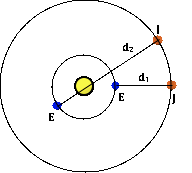Waves, Sound and Light: Light Waves
Light Waves: Audio Guided Solution
Problem 3:
 In the 1600s, Ole Roemer became one of the first scientists to make a measurement of the speed of light. Roemer observed the orbits of Jupiter’s nearest moon and recognized that its orbital period was observed to be approximately 22 minutes longer when measured from Earth when it was furthest from Jupiter compared to when it was closest to Jupiter. Roemer reasoned that the difference was due to the fact that it took longer for light from Jupiter to travel the extra distance when Earth’s position was on the opposite side of the Sun from Jupiter. The distance d2 is 2.98x1011 m greater than the distance d1. Determine Roemer’s estimate of the speed of light in the 1600s.
In the 1600s, Ole Roemer became one of the first scientists to make a measurement of the speed of light. Roemer observed the orbits of Jupiter’s nearest moon and recognized that its orbital period was observed to be approximately 22 minutes longer when measured from Earth when it was furthest from Jupiter compared to when it was closest to Jupiter. Roemer reasoned that the difference was due to the fact that it took longer for light from Jupiter to travel the extra distance when Earth’s position was on the opposite side of the Sun from Jupiter. The distance d2 is 2.98x1011 m greater than the distance d1. Determine Roemer’s estimate of the speed of light in the 1600s.
Audio Guided Solution
Habits of an Effective Problem Solver
-
Read the problem carefully and develop a mental picture of the physical situation. If necessary, sketch a simple diagram of the physical situation to help you visualize it.
-
Identify the known and unknown quantities and record in an organized manner, often times they can be recorded on the diagram itself. Equate given values to the symbols used to represent the corresponding quantity (e.g., v = 3.00x108 m/s, λ = 554 nm, f = ???).
-
Use physics formulas and conceptual reasoning to plot a strategy for solving for the unknown quantity.
-
Identify the appropriate formula(s) to use.
-
Perform substitutions and algebraic manipulations in order to solve for the unknown quantity.
Read About It!
Get more information on the topic of Light Waves at The Physics Classroom Tutorial.
Return to Problem Set
Return to Overview
View Audio Guided Solution for Problem:
1 |
2 |
3 |
4 |
5 |
6 |
7 |
8 |
9 |
10 |
11 |
12 |
13 |
14 |
15 |
16 |
17 |
18 |
19 |
20 |
21 |
22 |
23 |
24 |
25